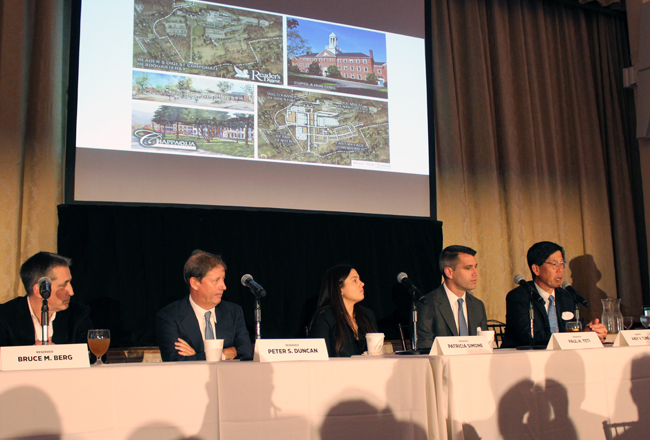Developers discuss challenges, benefits of adaptive reuse
 Giving new life to an older building through adaptive reuse offers a number of benefits and limitations compared with building from the ground up, a panel of developers said during a recent “Adaptive Use and Reuse” discussion presented by the Westchester and Fairfield County Business Journals.
Giving new life to an older building through adaptive reuse offers a number of benefits and limitations compared with building from the ground up, a panel of developers said during a recent “Adaptive Use and Reuse” discussion presented by the Westchester and Fairfield County Business Journals.
“The difference is every once in a while, skeletons come out of the closet in older buildings,” Peter S. Duncan, president and CEO of George Comfort & Sons Inc., said during the April 25 luncheon event at the C.V. Rich Mansion in White Plains.

George Comfort & Sons leads a group of investors that aims to transform the former on North Broadway in White Plains into a mix of student housing, apartments and an assisted-living facility. The 16-acre property adjoining the Pace University law school was used for more than a century by a teaching order of Roman Catholic nuns, Sisters of the Divine Compassion.
The redevelopment plan calls for 400 rental housing units in two 10-story buildings, a separate facility with 70 units of student housing for Pace University and a 125-bed assisted living facility. The developer plans to preserve two historic buildings on the property: the Sisters of Divine Compassion chapel and the Mapleton House.
“It”™s always a very interesting process,” Duncan said of adaptive reuse.
Challenges even include Simone Development Cos. also faced a number of challenges during its $35 million redevelopment of the in Yonkers. The roughly seven-acre property at 1086 N. Broadway has been transformed into an 85,000-square-foot mixed-use facility that will open with its first tenant later this month.
Before it sat vacant and crumbling for nearly 40 years, the 52,000-square-foot Georgian Revival building for decades housed a nonprofit horticultural research center built by international financier William Boyce Thompson.
“It is a beautiful building,” Patricia Simone, president of Simone Management Cos., said on the panel. “It just was left alone too long and not maintained, and we saw that there really was no reason to tear it down and start from scratch.”

Aside from the building”™s neglected condition and graffiti-covered walls, the Boyce Thompson Center also provided its own unique natural challenges.
“There were the largest raccoons in there that I have ever seen,” Simone said with a laugh.
Simone said the area of Yonkers surrounding the Boyce Thompson Center is underserved with both retail and restaurant options. “A large part of our business plan is based on adaptive reuse, so when we look at a property, we”™re looking for the need,” she said. “You have to identify the need and figure how to fulfill that need.”
In addition to St. John”™s Hospital and Westmed Medical Group, tenants at Simone”™s new center will include Italian restaurant Fortina, The Taco Project, Family Wellness Pharmacy, specialty hair salon Plushblow and sunglasses retailer Ultimate Spectacle.
Paul H. Teti, partner at Normandy Real Estate Partners, the New Jersey-based owner of The Exchange office-park portfolio along Westchester Avenue in White Plains and Harrison, said that his company focuses on breathing life into existing assets and repositioning them physically to meet the demand of today”™s market.

To meet those demands, the company plans to buildings at 106, 108 and 110 Corporate Park Drive in Harrison as a Wegman”™s supermarket site. The office buildings are expected to have an overall occupancy rate of about 2 percent this year, according to a 2016 filing with the Harrison Planning Board.
The office-park landlord also has vacated and mothballed two office buildings at 103 and 105 Corporate Park Drive, which will be razed this year to make way for a 421-unit rental apartment complex, The Residences at Corporate Park Drive. That project, the first residential development on Westchester”™s Platinum Mile commercial corridor, includes Toll Brothers, the luxury homes builder, as Normandy”™s partner.
“It was really taking a step back and saying, ”˜What”™s missing and where can we add it?”™” Teti said. “If we can add it within the four walls of our office buildings, great. If we can”™t, let”™s look creatively and say perhaps these buildings that are close to being empty should be empty and should be looked at with a fresh set of eyes.”

Teti said he hopes the property”™s new uses will continue the positive momentum the Platinum Mile has seen in recent years “by taking some antiquated product out of the market that would otherwise put a downward pressure on both (leasing) velocity and rent.”
Normandy”™s plans follow the town of Harrison”™s adoption of a revised master plan in 2013 that includes a mixed-use zone for that office-park area to allow certain residential development, as well as retail and restaurants approved for special exception permits. The plan was revised in response to the town”™s shrinking commercial tax base on the Platinum Mile.
“Although the age of the office buildings on Westchester Avenue or the Platinum Mile was great for Westchester, its time had passed,” said panelist Andrew V. Tung, a landscape architect and partner at Divney Tung Schwalbe, a land use planning and consulting firm in White Plains. “Nobody wanted to be there anymore, and it was unlikely they were coming back to those types of office buildings, so there was a recognition in the town that they had to look to different options.”
Tung said that in adaptive reuse projects, his company”™s main goal is “to manage change on the site and in the neighborhood.”
“For all projects, we know that we have to present what”™s there, what”™s proposed and what the difference is,” he added.
Tung”™s company works with the owners of the former Reader”™s Digest corporate headquarters near Chappaqua in the town of New Castle. After a contentious 11-year effort to obtain town approval of a redevelopment proposal, Summit/Greenfield Partners, the Connecticut joint-venture owner of the property, is creating a mixed-use campus composed of 500,000 square feet of renovated office space, 120,000 square feet of retail stores anchored by a Whole Foods supermarket and 111 residences in low-rise buildings and attached townhomes.
“For adaptive reuse projects, oftentimes a facility has been in the community for a long time,” Tung said. “People have expectations about how it works within that community. It may in fact, as with Reader”™s Digest in Chappaqua, have been there longer than many of the neighbors or residents of the community.”
Tung added that changes, whether they be social, physical or economic, can cause a facility”™s intended use to no longer make sense. “It requires a change of attitude, a change of sensibility and it really requires a partnership” between all stakeholders, he said.
Bruce M. Berg, CEO of Fuller Development Co. LLC, the development arm of the Cappelli Organization in White Plains, agreed that working collaboratively with municipalities is key. During the company”™s development of properties in downtown White Plains, including The Residences at the Ritz-Carlton, the firm agreed to construct an extension to Court Street, an infrastructure project Berg said the city had hoped to accomplish for decades.
The Cappelli company hopes to replicate its success in Stamford. The company is in the midst of a two-phase project in the city”™s downtown with RXR Realty that includes the redevelopment of the former post office at 421 Atlantic St. Dubbed Atlantic Station, the mixed-use development will feature 650 rental apartments and 50,000 square feet of ground-floor retail and restaurants.
“We clearly like being in cities where we think we can have an impact or we”™re going to help change the neighborhoods that we”™re in,” Berg said.